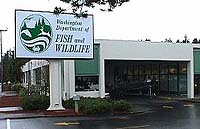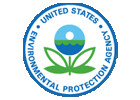ADDED 5/11/09: This story makes headlines across the country! High Country News reports it here: “Heard around the West: Deja Poo”
*************
On April 8, City inspections of a local stormdrain system that borders Rosemere found a dangerous cross connection with sewage lines. The problem was identified using specialized remote cameras in the stormdrain system. Unfortunately, the cross connection occurs at the Southwest Regional Office of the Washington State Department of Ecology. This means that raw sewage from a large and heavily staffed state office dedicated to environmental protection has literally been discharging to Burnt Bridge Creek for at least a dozen years.

Upon discovery of the cross connection, Ecology immediately closed its offices and shut down access from bathrooms and sinks. However, the cumulative damage of this illicit discharge has been flowing downstream, through residential areas, where it has contributed to water quality problems. Burnt Bridge Creek flows into Vancouver Lake, a troubled public recreation area that suffers seasonal toxic blue-green algal blooms casued by nutrients such as the type found in sewage. The cross connection will be repaired beginning April 13, and the City acknowledges that it is researching the paper trail to determine how this mistake could have been made. Today RNA submitted a Public Disclosure Request to the City Attorney’s Office and Public Works to receive copies of city inspection records, design plans and contractor permits specific to Ecology’s remodel project at the building in question. It appears that City Staff contributed to the problem since the project was inspected and approved through the city Development Review Office.
The cross connection may have occurred when Ecology retrofitted the building with additional restroom facilities as leasehold improvements when the regional offices planned to move into a former retail outlet. Contractors who installed the plumbing during the remodel connected the new sewer lines to the stormdrain system rather than to the sanitary sewer. The affected stormdrain system allows untreated discharge to Burnt Bridge Creek nearly a mile away. The pre-existing restroom facilities on location appear to be properly connected to the sanitary sewer lines, so the problem may be limited to the newer construction.
The Rosemere Neighborhood Association has worked tirelessly to draw attention to contamination in Burnt Bridge Creek, focusing heavily on exceedences of fecal coliform. The creek has failed state water quality standards on various parameters, including fecal coliform, for many years. RNA has brought these concerns before the City of Vancouver, Clark County Health Department, Environmental Protection Agency, the State Department of Ecology, and the Vancouver Lake Watershed Partnership. Burnt Bridge Creek is currently under a state Total Maximum Daily Load study to determine how to alleviate failed water quality standards, including exceedences of fecal coliform. RNA advocated for the state to perform this study in light of sewage concerns.
Though problem solving has been painfully slow over the years, new actions are helping to alleviate this environmental and public health stress, and RNA has been actively involved at various points. In the Burnt Bridge Creek basin, there are approximately 5000 properties where it is uncertain if each property is connected to sanitary sewer or if it relies upon septic tanks. In either case, sewage fees may not be paid, or septic tanks are not being regulated and inspected and could be failing. RNA has met for several years with various agencies to advocate for universal record keeping and mapping of on site septic systems and stormdrains, and to better regulate maintenance and operations standards to help reduce septic failures that pollute ground and surface water.
In June 2004, RNA filed a Citizen’s Clean Water Act lawsuit against the City of Vancouver, alleging that the City’s stormdrain system was absorbing and carrying contamination to surface water, including E.coli and fecal coliform. The complaint specified that human waste (presumably from septic tanks) was part of the contaminant load in the stormdrains. RNA hired a laboratory to test flows discharging from the stormdrain pipes, and results clearly indicated elevated levels of E.coli. City staff dismissed the data claiming that the problem is largely attributed to wildlife and domestic animals, not human beings.
The lawsuit resulted in a legally binding settlement agreement wherein the City of Vancouver agreed to adopt the state’s Stormwater Management Manual of Western Washington (2005) on an accelerated schedule as part of the City’s stormwater permit. Though the deadline for adoption of the state stormwater regulations was July 2008, to date the City has failed to abide by these terms and is still in violation of the settlement agreement. The settlement agreement also calls for the city to conduct outfall field screening of all known city-owned outfalls on both Burnt Bridge Creek and the Columbia River. Such screening calls for the used of Illicit Discharge Detection and Elimination (IDDE) programs where outfalls are tested for contaminants, and identified exceedences can then be traced back up the stormdrain system to the contaminant source. Had the City of Vancouver followed the protocols of the IDDE technical assessment as specified in the settlement agreement, the cross connection at Ecology’s building, and other potential cross connections, could have been found earlier.
Another result of RNA’s lawsuit was an organized survey of all properties in the Rosemere neighborhood. The “Smoketest” survey identified at least three cross connections between the sanitary sewer and stormdrain systems that were immediately repaired. The survey also found several houses on ‘K’ street that were previously not known to be connected to sanitary sewer.
RNA has advocated for signage to be posted along the creek that declare the water is unsafe for human contact, and the City of Vancouver finally agreed to post signage along the newly developed Burnt Bridge Creek Greenway Project. RNA often referred to a 1999 Mircrobial Source Tracking Study that states “The human sources of microbial pollution appear to be the major contributor of Burnt Bridge Creek E.coli. Furthermore, the majority of the human matches are to E.coli clones found in septic tanks.” This study shows that E.coli from human origin accounts for as high as 42% of the identified microbes at monitoring stations along the creek. Unfortunately, the City did not finalize the Microbial Report, did not submit the data to the state, and dismissed the conclusions and recommendations that clearly named human-sourced E.Coli as a primary souce of waterborne pollution in Burnt Bridge Creek.
Inspite of slow action, it is now very clear that human waste is entering local surface water bodies, and a concerted effort is needed to fully map and inventory the stormdrain systems, sanitary sewer lines, and septic tanks to ensure public health and safety and to prevent adverse impacts to the environment and the local potable water supply.











![Washington State Water Quality Assessment [303(d)] Washington State Department of Ecology](http://www.rosemerena.org/home/wp-content/uploads/2009/03/ecy_logo.gif)

